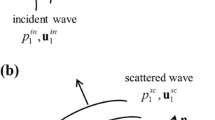Abstract
The implosion of A19 incandescent lightbulbs in a high-pressure water environment is studied in a 1.77-m-diameter steel tank. Underwater blast sensors are used to measure the dynamic pressure field near the lightbulbs and the implosions are photographed with a high-speed movie camera at a frame rate of 24,000 pps. The movie camera and the pressure signal recording system are synchronized to enable correlation of features in the movie frames with those in the pressure records. It is found that the gross dimensions and weight of the bulbs are very similar from one bulb to another, but the ambient water pressure at which a given bulb implodes (\(P_a\), called the implosion pressure) varies from 6.29 to 11.98 atmospheres, probably due to inconsistencies in the glass wall thickness and perhaps other detailed characteristics of the bulbs. The dynamic pressures (the local pressure minus \(P_a\), as measured by the sensors) first drop during the implosion and then reach a strong positive peak at about the time that the bulb reaches minimum volume. The peak dynamic pressure varies from 3.61 to 28.66 atmospheres. In order to explore the physics of the implosion process, the dynamic pressure signals are compared to calculations of the pressure field generated by the collapse of a spherical bubble in a weakly compressible liquid. The wide range of implosion pressures is used in combination with the calculations to explore the effect of the relative liquid compressibility and the bulb itself on the dynamic pressure field.
















Similar content being viewed by others
References
Carman A (1905) Resistance of tubes to collapse. Phys Rev 21:381–387
Carman A (1917) The collapse of short thin tubes. University of Illinois Engineering Experiment Station Bulletin 99
Carman A, Carr M (1906) Resistance of tubes to collapse. University of Illinois Engineering Experiment Station Bulletin 5
Cook G (1925) The collapse of short tubes by external pressure. Philos Mag 50:844–848
Ghiotto A, Penrose JD (2000) Investigating the acoustic properties of the underwater implosions of light globes and evacuated spheres. In: Proceeding Austr Acoust Soc Conf, pp 1–8
Heard GJ, McDonald M, Chapman NR, Jashke L (1997) Underwater light bulb implosions: a useful acoustic source. Proc IEEE Oceans 2:755–762
Ikeda CM, Wilkerling J, Duncan JH (2013) The implosion of cylindrical shell structures in a high-pressure water environment. In: Proceedings of Royal Society Series A 469. doi:10.1098/rspa.2013.0443
Keller JB, Kolodner II (1956) Damping of underwater explosion bubble oscillations. Appl Phys 27:1152–1161
Orr M, Schoenberg M (1976) Acoustic signatures from deep water implosions of spherical cavities. J Acoust Soc Am 59:1155
Saunders H, Windenburg D (1931) Strength of thin shells under external pressure. Transcr Am Soc Mech Eng 53:207
Southwell R (1913) On the collapse of tubes by external pressure. Philos Mag 2:502–511
Southwell R (1915) On the collapse of tubes by external pressure. Philos Mag 29:67–77
Sturm R (1941) A study of the collapsing pressure of thin-walled cylinders. University of Illinois Engineering Experiment Station Bulletin 329
Turner SE (2007) Underwater implosion of glass spheres. J Acoust Soc Am 121(2):844–852
Turner SE, Ambrico JM (2013) Underwater implosion of cylindrical metal tubes. J Appl Mech 80:1–11
von Mises R (1929) Der kritische aussendruck fur allseits belastete zylindrischer rohre (the critical external pressure of cylindrical tubes under uniform radial and axial load), translated by df winden-burg in 1933. Festschrift, Prof Dr A Stodola, Orell Fussli Veriag 53:418–430
Windenburg D, Trilling C (1934) Collapse by instability of thin cylindrical shells under external pressure. Transcr Am Soc Mech Eng 56(2):819–825
Acknowledgments
The support of the Office of Naval Research under Grant N000140410701, Program Manager Louise Couchman, is gratefully acknowledged.
Author information
Authors and Affiliations
Corresponding author
Electronic supplementary material
Below is the link to the electronic supplementary material.
Rights and permissions
About this article
Cite this article
Czechanowski, M., Ikeda, C. & Duncan, J.H. The pressure field of imploding lightbulbs. Exp Fluids 56, 64 (2015). https://doi.org/10.1007/s00348-015-1913-y
Received:
Revised:
Accepted:
Published:
DOI: https://doi.org/10.1007/s00348-015-1913-y




